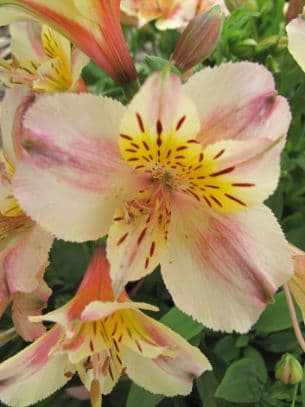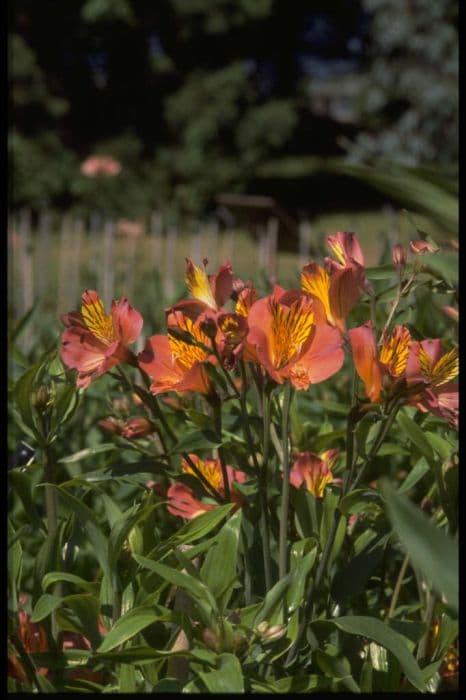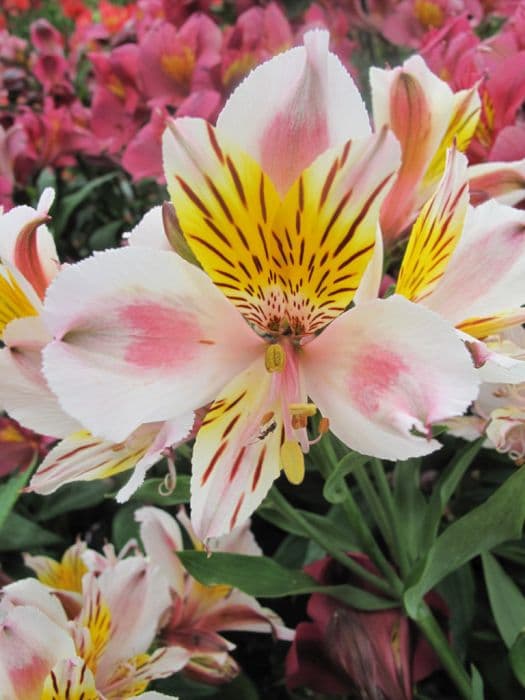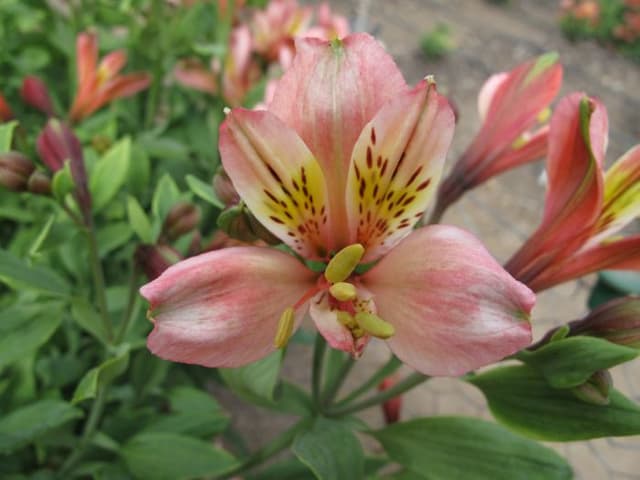Peruvian Lily Alstroemeria aurea

ABOUT
The plant known as Peruvian lily showcases an exquisite combination of colorful and often spotted flowers that generally bloom in hues of yellow, orange, pink, and purple, among other pastel shades. The flowers themselves are trumpet-shaped, comprising six petals that spread outwards with a flared appearance. Richly textured, the petals often exhibit striking patterns and contrasting streaks, which contribute to their ornamental allure. Born on tall, erect stems, these blossoms come together in clusters, creating a lush display. The leaves of the Peruvian lily are narrow and lance-shaped, with a glossy green color that complements the vibrancy of its flowers. The foliage often twists slightly from the base, adding to the plant's dynamic visual texture. As a perennial, it brings a dependable and recurring splash of color to the garden, with blooms appearing most profusely during the late spring and early summer months. The Peruvian lily is not only known for its beauty but also for its resilience. It often proves capable of withstanding less-than-ideal conditions and can persist where more delicate plants might fail. For these reasons, the Peruvian lily remains a popular choice both for garden cultivation and as a cut flower, celebrated for its longevity and the vibrant life it brings to any setting.
About this plant
 Names
NamesFamily
Alstroemeriaceae
Synonyms
Peruvian Lily, Lily of the Incas, Inca Lily, Parrot Lily, Peruvian Lily, Golden Lily of the Incas
Common names
Alstroemeria aurantiaca, Alstroemeria psittacina var. aurantiaca, Alstroemeria chilensis var. aurantiaca, Alstroemeria aurea var. aurantiaca.
 Toxicity
ToxicityTo humans
The Peruvian lily, which Alstroemeria aurea is commonly known as, is not considered highly toxic to humans. However, it can cause minor irritations. If ingested, parts of the plant may cause stomach upset or mild gastrointestinal issues. The sap can potentially cause skin irritation or dermatitis in sensitive individuals upon contact. It's advisable to handle the plant with care and to seek medical attention if significant symptoms develop following exposure or ingestion.
To pets
The Peruvian lily is considered to have low toxicity to pets. When ingested by cats or dogs, it can potentially cause mild gastrointestinal upset, including symptoms like vomiting or diarrhea. Generally, the toxicity is not severe, but it is still recommended to prevent pets from eating the plant. If a pet consumes a significant amount of the Peruvian lily and shows symptoms of distress or continued gastrointestinal discomfort, it is wise to consult a veterinarian.
 Characteristics
CharacteristicsLife cycle
Perennials
Foliage type
Deciduous
Color of leaves
Green
Flower color
Orange
Height
2-3 feet (0.6-0.9 meters)
Spread
1-2 feet (0.3-0.6 meters)
Plant type
Herb
Hardiness zones
7
Native area
South America
Benefits
 General Benefits
General Benefits- Decorative Appeal: Alstroemeria aurea, commonly known as Peruvian Lily, adds vibrant color to gardens and bouquets with its bright and varied flower hues.
- Long-Lasting Blooms: The Peruvian Lily's flowers have a lengthy bloom time, providing color from late spring to early fall.
- Attracts Pollinators: This plant attracts bees, butterflies, and hummingbirds, which are essential for pollination and promoting biodiversity.
- Easy to Grow: Peruvian Lilies are relatively easy to cultivate, making them suitable for gardeners of various skill levels.
- Drought Tolerance: Once established, the Peruvian Lily exhibits some drought tolerance, which is beneficial in water-scarce environments.
- Low Maintenance: Aside from regular watering and occasional fertilization, Peruvian Lilies require minimal care.
- Cut Flower Availability: The cut flowers of the Peruvian Lily are long-lasting in vases, making them excellent for floral arrangements.
 Medical Properties
Medical Properties- This plant is not used for medical purposes.
 Air-purifying Qualities
Air-purifying QualitiesThis plant is not specifically known for air purifying qualities.
 Other Uses
Other Uses- Floral Art: Alstroemeria aurea, commonly known as Peruvian Lily, is often used in decorative floral arts due to its vibrant colors and unique petal shapes, making it a staple in contemporary flower arrangements.
- Ecosystem Support: The plant provides habitat and food for various pollinators, including bees and butterflies, thus supporting local ecosystems and biodiversity.
- Tattoo Design Inspiration: Its intricate flowers and patterns are sometimes used as design inspiration for tattoos, symbolizing friendship, devotion, and mutual support.
- Garden Border Decoration: The Peruvian Lily can be used to create colorful borders in gardens, due to its upright, bushy form and repeated blooming.
- Fashion Design: The striking appearance of the Peruvian Lily has inspired prints and motifs in fashion design, lending a touch of nature's aesthetics to clothing and accessories.
- Photography Subject: The unique beauty of Alstroemeria aurea makes it a popular subject for botanical photographers and nature enthusiasts.
- Crafting Dried Flowers: The flowers of the Peruvian Lily can be dried and preserved, retaining their color and shape well, to use in craft projects such as wreaths and dried floral arrangements.
- Color Dye Source: Historically, natural dyes have been extracted from the colorful blossoms of the Peruvian Lily to tint fabrics and materials.
- Education and Research: The plant is used in the study of floriculture and plant breeding due to its diverse color variants and patterns, which are of interest to genetic research.
- Edible Flowers: Although not widely recognized as a food source, the petals of Alstroemeria aurea can be used as a decorative edible garnish in culinary presentations, provided they are free of pesticides.
Interesting Facts
 Feng Shui
Feng ShuiThe Peruvian Lily is not used in Feng Shui practice.
 Zodiac Sign Compitability
Zodiac Sign CompitabilityThe Peruvian Lily is not used in astrology practice.
 Plant Symbolism
Plant Symbolism- Friendship and Devotion: Alstroemeria, commonly known as the Peruvian lily or lily of the Incas, often symbolizes strong bonds of friendship due to its twisted leaves which represent the intertwining of people and mutual support.
- Wealth and Prosperity: Some believe that the Peruvian lily signifies wealth and prosperity, stemming from its lush blooms and long-lasting nature.
- Achievement and Success: The vibrant and showy flowers are thought to be a symbol of striving for success and are often given to congratulate someone on an accomplishment.
- Fortune: Peruvian lilies are also said to bring good fortune to the receiver, making them a popular gift for new ventures.
 Water
WaterPeruvian lilies should be watered regularly to maintain moist, but not soggy, soil, typically about 1 gallon per week during the growing season. Reduce watering in the winter when the plant is dormant, ensuring the soil doesn't completely dry out. On hot summer days, they may require additional water to prevent stress, possibly reaching up to 2 gallons per week, depending on the weather. Always check the soil moisture before watering to avoid waterlogging, which can lead to root rot.
 Light
LightPeruvian lilies thrive in bright, indirect light or partial shade, especially in regions with intense sunlight. The ideal spot for these plants is where they receive morning sun and afternoon shade, as too much direct sun can scorch their leaves. However, too little light can reduce flowering, so a balance of light exposure is key to their growth and blooming.
 Temperature
TemperaturePeruvian lilies do best in temperatures ranging from 60 to 80°F. They can withstand brief periods of colder weather down to about 20°F but should be protected from frost. The ideal conditions for the plant include warm days and cooler nights; extreme heat or cold can negatively impact the plant's health and flowering potential.
 Pruning
PruningPeruvian lilies benefit from pruning to remove spent flowers and encourage further blooming. Prune the stems back to the ground level in late fall or early winter to promote healthy growth for the next season. This also helps to control the spread of the plant, as it can become invasive if not managed properly.
 Cleaning
CleaningAs needed
 Soil
SoilPeruvian lily thrives in a soil mix that is fertile, well-draining, and slightly acidic to neutral in pH (6.0 to 7.0). A good mixture would be two parts loam, one part peat or compost, and one part sharp sand or perlite to improve drainage. Consistent moisture is important, but the soil must not become waterlogged.
 Repotting
RepottingPeruvian lily, often not requiring frequent repotting, does best when its roots are undisturbed. It can be repotted every 2 to 3 years or when it has outgrown its current container, showing signs like roots emerging from drainage holes.
 Humidity & Misting
Humidity & MistingPeruvian lily prefers moderate humidity conditions. While specific humidity levels are not critical, a level around 40-60% is generally conducive to their health. Avoid excessively dry conditions which can lead to leaf desiccation.
 Suitable locations
Suitable locationsIndoor
For Peruvian lily, ensure bright, indirect light and not too warm.
Outdoor
Plant Peruvian lily in partial sun, sheltered from strong winds.
Hardiness zone
7-10 USDA
 Life cycle
Life cycleAlstroemeria aurea, commonly known as Peruvian Lily or Lily of the Incas, begins its life cycle with seed germination, which typically occurs in a warm, moist environment. The sprouting seed develops into a seedling with leaves and roots, with the young plant gradually maturing and forming a rhizomatous root system. As it grows, the Peruvian Lily develops long, lance-shaped leaves and sturdy stems; in its reproductive stage, it produces clusters of colorful, funnel-shaped flowers known for their striking patterns and markings. Following pollination, which often involves insects, the flowers develop into capsule-like fruits that contain numerous tiny seeds. Once mature, these seeds are dispersed by natural forces such as wind or by passing animals, ready to start the next generation if conditions allow. Ultimately, after several seasons of growth and dormancy cycles influenced by environmental conditions, Alstroemeria aurea completes its life cycle, with each individual plant potentially capable of living for many years with proper care.
 Propogation
PropogationPropogation time
Spring-Early Summer
Propogation: Alstroemeria aurea, commonly known as the Peruvian lily or lily of the Incas, is often propagated by division, which is its most popular method. The best time to propagate these plants is in the late winter or early spring when they are coming out of dormancy but before they have begun their active growth cycle. To divide Peruvian lilies, carefully dig up the clump of tubers and gently separate them by hand, ensuring that each division has at least one or two growth points or "eyes." These divisions can then be replanted in well-draining soil at a depth of about 6 to 8 inches (15 to 20 centimeters). They should be spaced approximately 12 to 18 inches (30 to 46 centimeters) apart to allow room for growth. Water the newly planted divisions thoroughly to help settle the soil around the tubers and initiate the growth process.

![Peruvian lily [Princess Fabiana]](/_next/image?url=https%3A%2F%2Fplants-admin.emdemapps.com%2Fimages%2Fplants%2F%2Fimages%2F604b58855f4ed.png&w=640&q=75)


![Peruvian lily [Princess Carmina]](/_next/image?url=https%3A%2F%2Fplants-admin.emdemapps.com%2Fimages%2Fplants%2F%2Fimages%2F604b5b436505f.png&w=640&q=75)



![Peruvian lily [Inca Glow]](/_next/image?url=https%3A%2F%2Fplants-admin.emdemapps.com%2Fimages%2Fplants%2F%2Fimages%2F604b5e99e48d9.png&w=640&q=75)
![Peruvian lily [Inca Smile]](/_next/image?url=https%3A%2F%2Fplants-admin.emdemapps.com%2Fimages%2Fplants%2F%2Fimages%2F604b5cad8fa91.png&w=640&q=75)